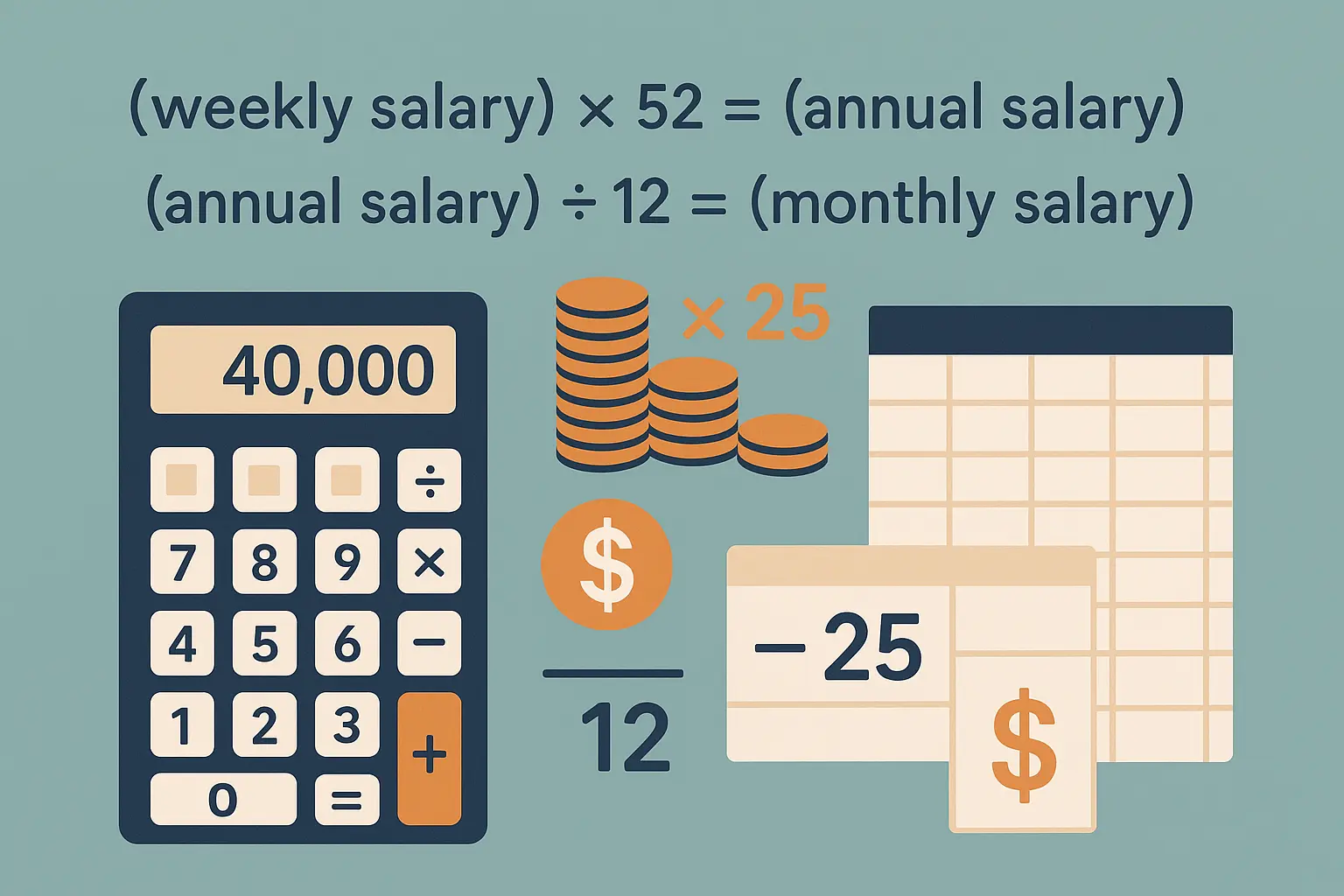Salary to Hourly Calculator: Why Your Annual Pay Might Be Fooling You (And How to Find Out)

That $75K salary sounds impressive until you realize you’re working 55-hour weeks. Suddenly, you’re making less per hour than your friend who earns $60K working standard 40-hour days. Let’s figure out what you’re actually earning.
Suddenly, you’re making less per hour than your friend who earns $60K working standard 40-hour days. Let’s figure out what you’re actually earning with a salary to hourly calculator so you can see the real numbers.
For instance, if you earn $50,000 annually working standard hours, your hourly rate works out to $24.04 per hour based on a 40-hour week for 52 weeks. But that’s just the beginning—your real hourly worth depends on overtime, benefits, taxes, and hidden costs that most people never calculate.
Table of Contents
- Getting the Math Right: Core Salary Conversion Methods
- Beyond Basic Numbers: Advanced Calculator Features That Actually Matter
- Using Your Hourly Rate for Career Power Moves
- Avoiding the Traps That Make Your Calculations Worthless
TL;DR
- The standard formula (Annual Salary ÷ 2,080 hours) works for most people, but you’ll need adjustments for PTO, overtime, and benefits
- Modern calculators can factor in taxes, location costs, and industry-specific variables for more accurate results
- Your hourly rate becomes a powerful negotiation tool when you know how to position it against market data
- Don’t forget hidden costs and career growth potential—they can make a lower hourly rate worth more long-term
Getting the Math Right: Core Salary Conversion Methods
Most people think converting salary to hourly is simple division, but your work situation changes everything. Using a salary to hourly calculator ensures your numbers reflect your actual schedule.
The Basic Formula (And When It Actually Works)
Take your annual salary and divide by 2,080 hours (40 hours × 52 weeks). A $50,000 salary works out to $24.04 per hour. This works great if you actually work those standard hours.
According to ADP’s payroll calculator, if an employee has a salary of $50,000 and works 40 hours per week, the hourly rate is $50,000/2,080 (40 x 52) = $24.04. This baseline calculation is what most HR departments use. This baseline calculation is what most HR departments use. For personal use, a free salary to hourly calculator can help you double-check these figures instantly.
But here’s the thing—most people don’t work exactly 40 hours. If you’re regularly pulling 50-hour weeks, that same $50,000 becomes $19.23 per hour. That’s a $5 difference that adds up to $10,400 less annually than you thought you were earning.
Let’s say you’re offered a position at $65,000 annually. Using standard calculation: $65,000 ÷ 2,080 hours = $31.25 per hour. Now you can compare this against other opportunities or your current role with real numbers.
When you’re ready to maximize these calculations for salary negotiations, understanding how to ask for a raise strategically becomes crucial for turning your hourly rate analysis into actual income increases.
The Real-World Adjustments That Change Everything
Several factors can make your salary-to-hourly conversion completely wrong if you don’t account for them. Let’s fix the numbers so they actually mean something.
Account for Your Actual Schedule
Track your hours for a month. Are you consistently working more than 40? Less? Use your real numbers, not what your job description says. A professional who thought they were earning $35 per hour discovered they were actually making $28 per hour when we factored in their consistent 50-hour weeks.
Don’t Forget PTO (The Reality Check)
You get paid for vacation days, but you’re not working them. Subtract from 2,080 standard hours and recalculate hourly rate with adjusted totals. A salary to hourly calculator that includes PTO options makes this much easier.
Quick PTO Calculation:
- Count total vacation days per year
- Add company holidays
- Include sick leave allowances
- Subtract from 2,080 standard hours
- Recalculate hourly rate with adjusted total
Include the Whole Package
Your base salary is just part of the story. Health insurance, 401k matching, and other benefits add real value to your hourly rate. Your health insurance might be worth $12,000 annually—add benefit values to your salary before converting, and it can boost your effective hourly rate by $5-8.
| Benefit Type | Annual Value | How to Calculate |
|---|---|---|
| Health Insurance | $8,000-$15,000 | Employer premium contribution |
| 401k Match | $2,000-$5,000 | Company matching percentage × your contribution |
| Paid Time Off | $3,000-$8,000 | (Vacation days + holidays) × daily rate |
| Professional Development | $1,000-$3,000 | Training, conferences, certifications |
| Total Benefits Value | $14,000-$31,000 | Add to base salary before conversion |
Quick example: You earn $65,000 with benefits worth $15,000, working 45 hours weekly. That’s $80,000 ÷ 2,340 hours = $34.19 per hour, not the $31.25 you’d get from basic math.
When Overtime and Bonuses Change Everything
Regular overtime pay and annual bonuses can significantly boost your effective hourly rate. Track these additional earnings over a full year to get an accurate picture of what you’re really making per hour.
Recent tax legislation could impact how you calculate overtime benefits. “The 2025 tax bill includes a deduction for overtime pay covered by the Fair Labor Standards Act” according to the Bipartisan Policy Center, which could effectively increase your take-home hourly rate for overtime work.
For detailed analysis on maximizing compensation increases, our salary increase calculator guide provides comprehensive strategies for boosting your earning potential.
Putting Your Numbers to Work
Once you’ve got accurate hourly rates calculated, you can use them for smart decision-making. Whether you’re comparing job offers, setting freelance rates, or planning your budget, these numbers become powerful tools.
Smart Job Comparisons
Comparing salaries across different positions becomes much clearer when you convert everything to hourly rates. Factor in work schedules, benefits, and total compensation to see which opportunity actually pays better per hour invested.
Let’s compare two job offers: Job A offers $75,000 with standard 40-hour weeks and excellent benefits worth $18,000. Job B offers $85,000 but expects 50-hour weeks with minimal benefits worth $8,000.
Job A: ($75,000 + $18,000) ÷ 2,080 = $44.71/hour
Job B: ($85,000 + $8,000) ÷ 2,600 = $35.77/hour
Despite the higher salary, Job B pays $9 less per hour.
Setting Your Freelance Rates
Converting your previous salary experience into freelance rates requires adding overhead costs, benefits replacement, and profit margins to your base hourly calculation. This ensures you’re not accidentally taking a pay cut when going independent.
Freelance Rate Calculator:
- Previous hourly rate: $______
- Add 25-30% for benefits replacement: $______
- Add 15-20% for business expenses: $______
- Add 10-15% profit margin: $______
- Target freelance rate: $______
Budget Planning That Makes Sense
Understanding your hourly earnings helps with financial planning and spending decisions. You can quickly calculate how many hours of work different purchases represent, making budgeting more tangible and meaningful.
Beyond Basic Numbers: Advanced Calculator Features That Actually Matter
Modern tools do more than math. An advanced salary to hourly calculator can handle taxes, location differences, and industry quirks that basic math can’t touch.. These advanced features can reveal significant differences in what jobs actually pay after all factors are considered.
Tax-Adjusted Reality
Gross pay means nothing if you don’t know your take-home. Advanced calculators show your after-tax hourly rate, which varies wildly by state. That $30/hour job in Texas might beat a $35/hour position in California once taxes hit.
When calculating take-home pay, ADP’s calculator shows you need to “calculate the sum of all assessed taxes, including Social Security, Medicare and federal and state withholding information” to determine the actual percentage of taxes taken from each paycheck. This approach ensures you’re working with real numbers, not gross estimates.
Location Makes Everything Different
A $70K salary in Kansas City has the same buying power as $95K in San Francisco. Use cost-of-living calculators before comparing opportunities in different cities. Your “raise” might actually be a pay cut.
Regional wage differences are becoming more pronounced. “The living wage of an adult in Louisiana with no children is $19.82 per hour” according to MIT’s Living Wage Calculator, highlighting how location dramatically impacts what constitutes adequate compensation.
Industry-Specific Reality Checks
Different industries have unique compensation structures that generic calculators can’t handle properly. Specialized tools account for sector-specific factors like expected overtime, irregular schedules, and variable pay structures.
Professional Services Expectations
Consulting and professional services? Factor in unpaid overtime expectations. Management and consulting roles often involve unpaid overtime and irregular schedules that industry-specific calculators account for to give you a more realistic hourly rate.
Contractor and Gig Economy Calculations
Moving from hourly to salary? You might be giving up overtime premiums and shift differentials worth thousands annually. 1099 work requires different calculations that include self-employment taxes, business expenses, and irregular income patterns.
Understanding salary sacrifice implications is crucial for contractors and gig workers, which is why our salary sacrifice calculator guide provides essential insights for optimizing tax-efficient compensation structures.
| Employment Type | Tax Considerations | Additional Costs | Calculation Adjustments |
|---|---|---|---|
| W-2 Employee | Employer pays half of payroll taxes | Minimal work expenses | Standard formula applies |
| 1099 Contractor | Self-employment tax (15.3%) | Business expenses, equipment | Add 25-35% to desired rate |
| Gig Worker | Quarterly tax payments | Vehicle, phone, supplies | Track all business deductions |
| Freelancer | Estimated tax payments | Professional insurance, software | Factor in irregular income |
Using Your Hourly Rate for Career Power Moves
Now that you know your real hourly worth, let’s put it to work. Smart professionals leverage these numbers for negotiations, career transitions, and long-term planning decisions that can significantly impact their earning potential.
Negotiation Ammunition
Your calculated hourly rate becomes strategic ammunition when you know how to use it properly. Hourly rate analysis gives you concrete data to support salary requests and position changes.
Prove Your Worth with Numbers
Calculate your productivity ratio. If you generate $200K in revenue annually while earning $60K, you’re producing $96 in value for every hour worked. That 3:1 ratio gives you serious negotiating power.
If you generate $200,000 in annual revenue for your company and earn $60,000 ($28.85/hour), you’re producing $96.15 in value for every hour worked. This 3.3:1 ratio gives you strong leverage to negotiate a raise that better reflects your contribution.
Market Research That Actually Works
Research comparable positions and convert everything to hourly rates. When you walk into salary negotiations with data showing market rates of $35-42/hour while you’re earning $28, you’ve got a compelling case.
Salary Negotiation Preparation:
- Calculate your current true hourly rate (including benefits)
- Research 5-10 comparable positions and convert to hourly
- Document your revenue generation or cost savings
- Prepare 3 specific examples of value creation
- Set target hourly rate increase (typically 10-20%)
Smart Career Transition Planning
Use conversion calculations to evaluate major career changes with clear financial impact analysis. Whether you’re considering education, remote work, or industry switches, hourly rates help quantify the real costs and benefits.
Education Investment Analysis
Will that MBA actually pay off? Calculate the hourly rate increase you’d need to justify the cost and time investment. Factor in lost wages during school and loan payments to see if the math works out.
Remote Work Trade-offs
Factor in commute time savings. If you save 10 hours weekly commuting, a slightly lower salary might actually increase your effective hourly rate. Home office costs and work-life balance improvements also factor into the equation.
Remote Work Compensation Analysis:
- Current salary: $______
- Commute time saved (hours/week): ______
- Transportation savings (annual): $______
- Home office expenses (annual): $______
- Remote position salary: $______
- Adjusted effective hourly rate: $______
Job Comparisons That Matter
Job A offers $75K with great benefits and 40-hour weeks. Job B offers $85K with minimal benefits and 50-hour expectations. Run the numbers—Job A might actually pay better per hour when you factor in the complete package.
Avoiding the Traps That Make Your Calculations Worthless
Perfect math won’t help if you’re missing the bigger picture. Even with accurate conversions, several common pitfalls can lead you astray and cost you money in the long run.
Hidden Costs You’re Ignoring
Work expenses eat into your real hourly rate and effectively reduce your net hourly compensation. Professional clothing, transportation, meals, and equipment all impact your take-home pay.
Hidden Work Expenses to Track:
- Professional wardrobe and dry cleaning
- Daily transportation or parking costs
- Work meals and coffee
- Professional licenses and certifications
- Home office equipment and utilities
- Professional development and networking
Track these for a month. You might discover your $25/hour job actually pays $22 after work-related costs. Don’t forget to subtract these costs from your calculations for a true picture.
The Career Growth Blind Spot
Sometimes a lower hourly rate now leads to much higher earnings later. Focusing solely on current hourly rates ignores promotion potential, skill development opportunities, and long-term earning capacity.
According to the Atlanta Fed’s Wage Growth Tracker, the median wage growth for matched individuals shows that workers who prioritize long-term career development often see compound hourly rate improvements that far exceed those who focus only on immediate compensation.
A $28/hour position with rapid promotion potential might beat a $35/hour dead-end job within two years. Don’t optimize for today’s hourly rate at the expense of tomorrow’s career trajectory.
Career progression often depends on having the right resume format that showcases your growing value proposition, which is why understanding professional resume formatting becomes crucial when transitioning to higher-paying roles.
When you’ve figured out your true hourly worth and identified your target compensation range, understanding what makes the best resume builders can help you actually land those higher-paying positions. Our AI-powered platform translates your salary research into interview opportunities by optimizing your resume for roles that match your calculated goals, helping you quantify achievements that justify premium compensation, and positioning you strategically across different salary tiers.
Final Thoughts
Your hourly rate is a compass, not a destination. Use these calculations to make informed decisions, but remember that numbers don’t capture everything that matters in your career.
Understanding your real hourly worth goes beyond simple math—it’s about making informed career decisions that align with your financial goals and life priorities. The calculations are just the starting point; how you use these insights to negotiate, plan, and position yourself professionally determines whether this knowledge actually improves your earning potential.
Sometimes the best move is taking that slightly lower hourly rate for better growth opportunities, work-life balance, or skills development. The goal isn’t maximizing your hourly rate—it’s making career choices that align with your complete financial picture and life priorities.
Numbers tell a story, but they don’t make decisions for you. Your calculated hourly rate should inform your choices, not limit them. Professionals who turn down opportunities with lower hourly rates sometimes miss career acceleration that would have dramatically improved their earnings within two years.
Whether you’re using basic formulas or a salary to hourly calculator with advanced features, the goal remains the same: making career choices based on complete information rather than surface-level numbers. Your time has value—make sure you’re getting paid what it’s actually worth.
Calculate your true worth, then use that knowledge to build the career you actually want.









